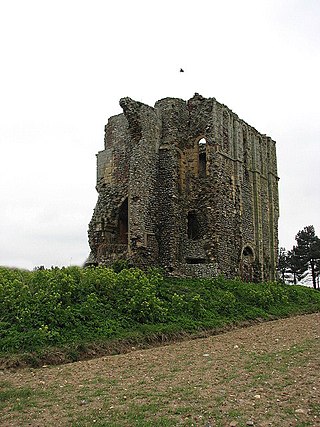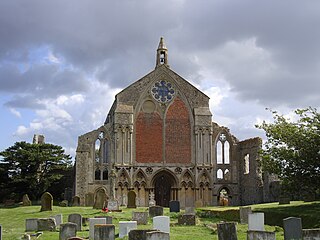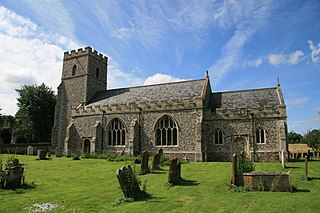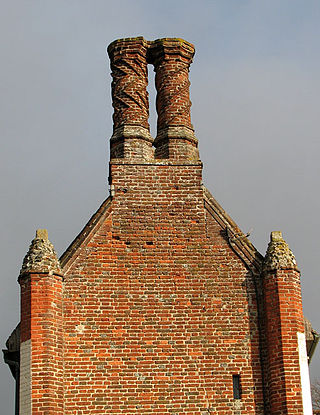Related Research Articles

Binham is a village and a civil parish in the English county of Norfolk. The village is 29.3 miles (47.2 km) north west of Norwich, 16.9 miles (27.2 km) west of Cromer and 124 miles (200 km) north north east of London. The village lies 4.9 miles (7.9 km) east south east of the town of Wells-next-the-Sea.

Bromholm Priory was a Cluniac priory, situated in a coastal location near the village of Bacton, Norfolk, England

St Mary's Priory, Binham, or Binham Priory, is a ruined Benedictine priory located in the village of Binham in the English county of Norfolk. Today the nave of the much larger priory church has become the Church of St. Mary and the Holy Cross and is still used as a place of worship. The remains of the priory are in the care of English Heritage. The abbey's west face is the first example in England of gothic bar tracery, predating Westminster Abbey by a decade.

West Acre is a village and civil parish in the King's Lynn and West Norfolk district of the county of Norfolk, England. It covers an area of 14.49 km2 (5.59 sq mi) and had a population of 187 in 83 households at the 2001 census, the population increasing to 260 at the 2011 Census.

Upwell is a village and civil parish in the English county of Norfolk. Upwell village is on the A1101 road, as is Outwell, its conjoined village at the north. The nearest towns are Wisbech to the north-west and Downham Market to the east.
Axholme Charterhouse or Axholme Priory, also Melwood Priory or Low Melwood Priory, North Lincolnshire, is one of the ten medieval Carthusian houses (charterhouses) in England. It was established in 1397/1398 by Thomas Mowbray, Earl of Nottingham and later Duke of Norfolk. The house was centred on a pre-existing chapel on the present Low Melwood Farm, between Owston Ferry and Epworth in the Isle of Axholme, which according to a papal bull of 1398 "was called anciently the Priory of the Wood".

St. Faith's Priory, Horsham, otherwise Horsham St. Faith Priory, was a Benedictine monastery in Horsham St Faith, Norfolk, England.

The Benedictine Priory, King's Lynn, was a medieval monastery in Norfolk, England. It was founded in 1100 in King's Lynn by Herbert de Losinga, bishop of Norwich, as a small monastic house supporting the church of St Margaret founded at the same time. Its rents and profits were remitted for the use of the priory of the Holy Trinity which served Norwich Cathedral, also founded around the same time by Bishop Herbert. The priory at King's Lynn was lucrative for many years but towards the end of its existence the income from it had fallen to less than the cost of maintaining it.

The Priory of St Mary de Bello Loco, commonly referred to as Molycourt Priory, was a small Benedictine priory located in the parish of Outwell, Norfolk, England.
St. Leonard's Priory, Norwich was a priory in Norfolk, England. It was a dependent cell of Norwich Cathedral before the Reformation. In 1542 it was acquired by the Earl of Surrey and turned into the mansion of Mount Surrey. During Kett's Rebellion, 1549, it was used as to imprison the rebel's 'gentry captives'.

Old Buckenham Priory was an Augustinian priory built on the site of Old Buckenham Castle at Old Buckenham in Norfolk, England.

Pentney Priory was an Augustinian priory at Pentney in the district of King's Lynn and West Norfolk, Norfolk, England. The ruins of the priory, mostly comprising the flint-built gatehouse, are Grade I listed.
Sporle Priory was a priory in Norfolk, England. It was founded in the early 12th century, and given to the monks of St. Florent free-of-charge as an alien priory. It was vacant for some time after the Black Death, and was dissolved in 1424.
Toft Monks Priory was a priory at Toft Monks, Beccles, Norfolk, England. It included St Margarets, Toft Monks and St Mary, Haddiscoe

Weybourne Priory was a small Augustinian medieval monastic house in Weybourne, Norfolk, England.

Rumburgh Priory was a Benedictine priory located in the village of Rumburgh in the English county of Suffolk. The priory was founded in about 1065 as a cell of St Benet's Abbey at Hulme in Norfolk. At the time of the Domesday Book in 1086 it had 12 monks. The ownership of the priory was transferred to St Mary's Abbey in York towards the end of the 12th century. The monks of Rumburgh were particularly devoted to St. Bee, whom they commemorated at Michaelmas.
Snape Priory was a priory in Suffolk, England. It was founded as a cell of the Benedictine St John's Abbey, Colchester in Essex.
Warmington Priory was a Benedictine priory or more probably a cell in Warmington, Warwickshire, England. It was apparently founded by the monks of Préaux Abbey in Normandy after Henry de Newburgh, earl of Warwick, gave them his lands in Warmington in the reign of Henry I of England. Whatever its initial status, by the 14th century it was a cell of Toft Monks Priory in Norfolk, which similarly belonged to Préaux Abbey. After the dissolution of the alien priories by Henry V it was granted in 1428 to the Carthusians of Witham Charterhouse in Somerset.
References
- 1 2 Pevsner, Nikolaus; Wilson, Bill (2002). Norfolk 1: Norwich and North East. Yale University Press. p. 585. ISBN 9780300096071.